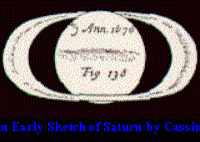From: Andrew Johnson Date: 2007-07-31 22:33:46 www.prisonplanet.com… Camp David “Crash” More Evidence Of 9/11 Media Scripting?CBS News reported that United Airlines Flight 93 had crashed at Camp David – 90 miles away from its alleged resting place in Somerset County, PA Paul Joseph WatsonPrison PlanetTuesday, July…





 From the time it was discovered in 1671 by Giovanni Domenico Cassini, Iapetus has always been something of a mystery. One of the amazing things to consider is that Cassini observed Iapetus, over 740 million miles distant, using a 17th century refracting telescope whose main lens was only two inches in diameter! (A refracting telescope is one in which only lenses are used, rather than a combination of lenses and mirrors.) When Cassini observed Iapetus over a period of time, he was puzzled – every 40 days or so, it seemed to disappear from view, then re-appear 40 days later. He suggested that Iapetus had a light side and a dark side, and that it always kept the same face turned to Saturn (in the same way that our moon always keeps the same face turned to the Earth).
From the time it was discovered in 1671 by Giovanni Domenico Cassini, Iapetus has always been something of a mystery. One of the amazing things to consider is that Cassini observed Iapetus, over 740 million miles distant, using a 17th century refracting telescope whose main lens was only two inches in diameter! (A refracting telescope is one in which only lenses are used, rather than a combination of lenses and mirrors.) When Cassini observed Iapetus over a period of time, he was puzzled – every 40 days or so, it seemed to disappear from view, then re-appear 40 days later. He suggested that Iapetus had a light side and a dark side, and that it always kept the same face turned to Saturn (in the same way that our moon always keeps the same face turned to the Earth).
 Just over 300 years after the discovery of Iapetus – on August 20th, 1977, Voyager 2 blasted off from the Kennedy Space Centre at Cape Canaveral, Florida. A 4-year journey of fabulous discoveries took the probe to the Saturnian System. In August 1981, we got our first close-up view of this orbiting oddity. Not surprisingly, little fanfare was made of this event, because Iapetus is a relatively obscure object.
Just over 300 years after the discovery of Iapetus – on August 20th, 1977, Voyager 2 blasted off from the Kennedy Space Centre at Cape Canaveral, Florida. A 4-year journey of fabulous discoveries took the probe to the Saturnian System. In August 1981, we got our first close-up view of this orbiting oddity. Not surprisingly, little fanfare was made of this event, because Iapetus is a relatively obscure object.
 The high resolution pictures returned were posted on the JPL Cassini Mission Website on 7th Jan 2005 (
The high resolution pictures returned were posted on the JPL Cassini Mission Website on 7th Jan 2005 ( Whilst it would be quite difficult for ordinary people to interpret radar data and come up with any sensible questions, there are other glaring oddities in the Iapetus photos that are on the NASA/JPL Websites. A closer look at the Iapetus images reveals some highly unusual craters. 2 Craters in particular are clearly not round. At least one crater is hexagonal in shape, with a raised mound in the centre. Another has an irregular shape (arguably more angular rather than circular) but it too, has an extraordinary linear ridge, roughly in the centre of the crater. Whether this crater formed as a result of an impact or through volcanic action, how can a linear ridge form approximately 24 miles (by my calculation) in length? Again, these extremely odd features are not addressed in NASA’s main description of the photograph.
Whilst it would be quite difficult for ordinary people to interpret radar data and come up with any sensible questions, there are other glaring oddities in the Iapetus photos that are on the NASA/JPL Websites. A closer look at the Iapetus images reveals some highly unusual craters. 2 Craters in particular are clearly not round. At least one crater is hexagonal in shape, with a raised mound in the centre. Another has an irregular shape (arguably more angular rather than circular) but it too, has an extraordinary linear ridge, roughly in the centre of the crater. Whether this crater formed as a result of an impact or through volcanic action, how can a linear ridge form approximately 24 miles (by my calculation) in length? Again, these extremely odd features are not addressed in NASA’s main description of the photograph.

